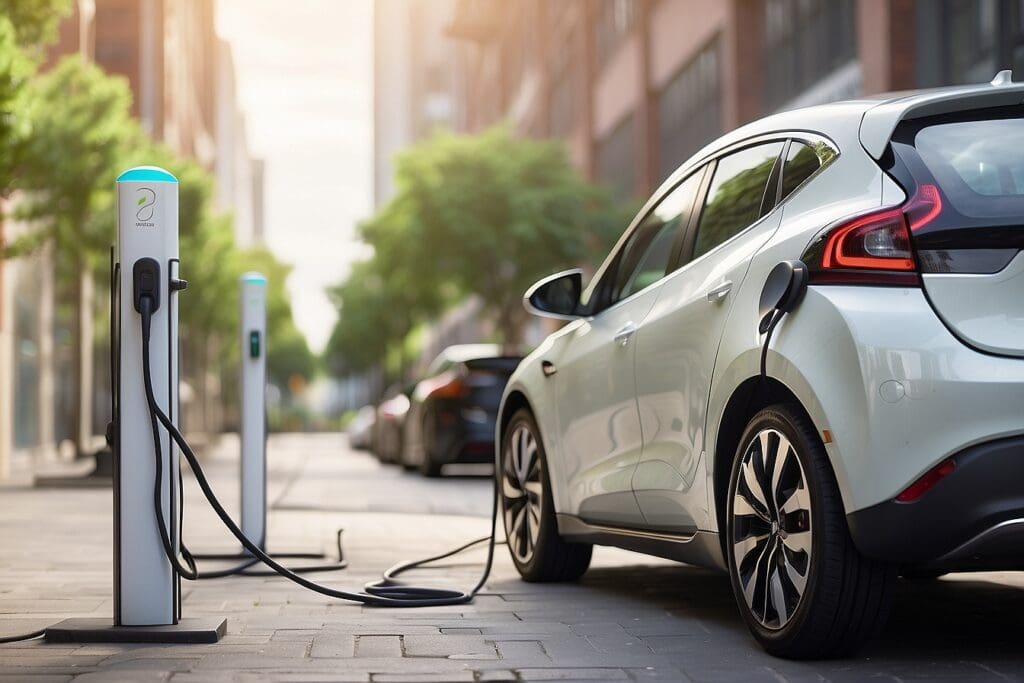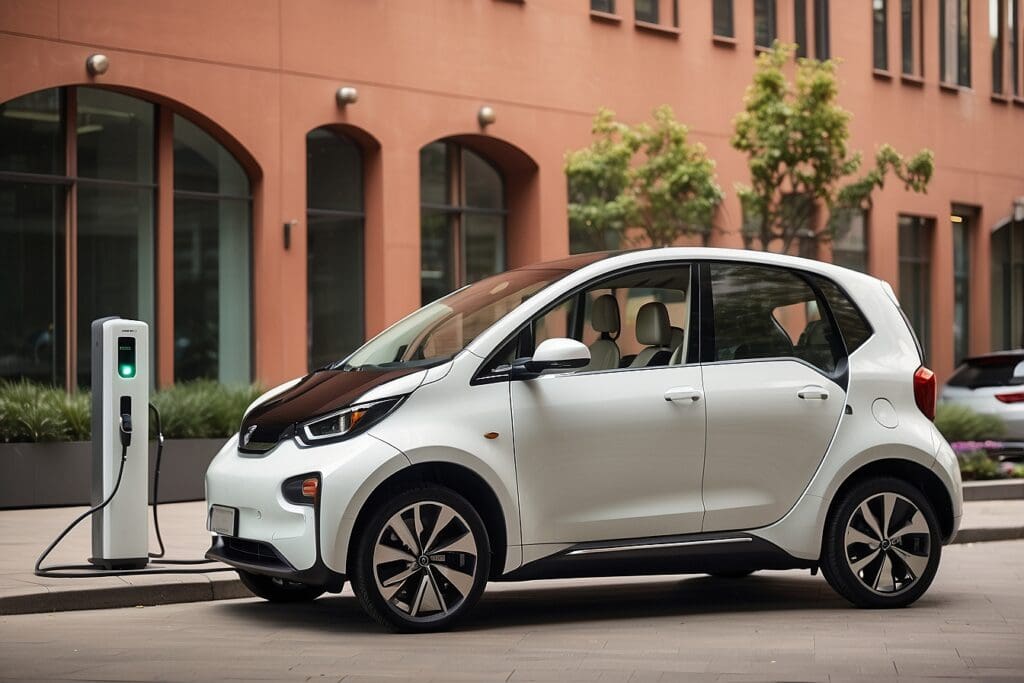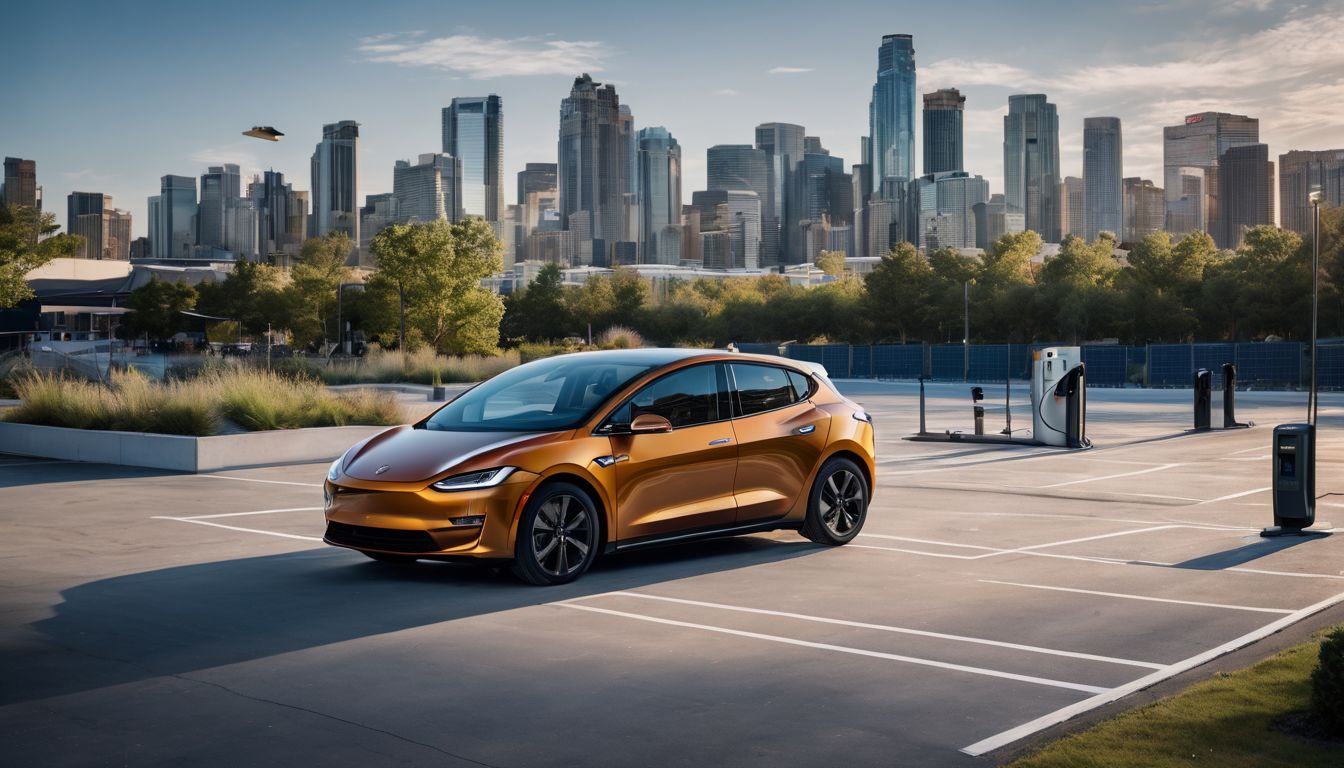As our cities burgeon and the air thickens with pollutants, many of us are acutely aware of the environmental pinch urban life is exerting. It’s something that touches each of our lives; we’re not merely onlookers but participants in this urgent call for change.
After rolling up our sleeves to delve into sustainable alternatives, it has become abundantly clear that electric vehicles (EVs) have the potential to be a pivotal force in moulding eco-friendlier metropolises—with prospects of purer air and more serene boulevards.
Take a moment to step into this exploration with us, as we uncover how EVs are steering us onto a path lined with hope for our cityscapes!
Key Takeaways
- Electric vehicles (EVs) are vital for creating cleaner, greener cities by lowering dependence on fossil fuels and reducing harmful emissions like carbon dioxide and nitrogen oxides.
- The spread of EVs is linked to economic benefits through job creation in areas such as manufacturing, maintenance, and the installation of charging infrastructure.
- Urban planning that incorporates EV charging stations encourages sustainable living and can transform urban spaces into more pedestrian-friendly zones.
- Collaboration between public and private sectors is key to developing a robust network of easily accessible EV charging stations across urban landscapes.
- Educating the public about the environmental and health benefits of electric vehicles can accelerate their adoption, contributing to improved air quality and resilience against climate change impacts.
The Rise of Electric Vehicles
Building on our exploration of urban sustainability, let’s turn our attention to electric vehicles (EVs), a driving force behind the green transportation revolution. Their adoption has skyrocketed in recent years as more people embrace sustainable transportation.
Electric mobility is no longer a futuristic idea; streets today buzz with these clean energy marvels, signalling a shift away from petrol and diesel engines.
We see car manufacturers racing to launch new EV models, tapping into the growing demand for vehicle energy efficiency. This surge in electric cars propels us toward low-carbon urban transportation and plays a crucial role in cutting carbon emissions.
With each electric vehicle that hits the road, we’re paving the way towards greener cities and smarter urban design. The transport sector’s electrification is underway, making strides for both environmental impact and innovative urban mobility solutions.
The Benefits of Electric Vehicles
Electric vehicles offer a reduced dependence on fossil fuels, lower emissions, and economic opportunities. They are an important aspect of urban sustainability, contributing to clean energy and enhanced air quality in cities.
Reduced dependence on fossil fuels
Electric vehicles play a pivotal role in reducing our dependence on fossil fuels. By shifting from traditional petrol-powered cars to electric vehicles, we significantly decrease the demand for non-renewable resources and contribute to a cleaner, more sustainable environment.
This transition aligns with the principles of conservation and renewable energy, aiding in our collective effort to build low-carbon urban transportation systems that support green cities and smart grid technology.
Furthermore, embracing electric vehicles contributes to the wider aim of sustainable energy practices. As environmentally conscious individuals who are committed to conserving natural resources and promoting clean energy solutions, integrating electric vehicles into our urban landscapes presents an opportunity to champion low-carbon mobility while fostering resilient communities against climate change impacts.
Lower emissions
Electric vehicles play a crucial role in reducing urban emissions, contributing to cleaner air and a healthier environment. By transitioning from traditional fuel-powered vehicles to electric ones, we significantly decrease harmful emissions such as carbon dioxide and nitrogen oxides that contribute to air pollution, smog, and climate change.
The use of low-carbon urban transportation like electric cars aligns with our commitment to sustainable living, promoting eco-friendly solutions for smarter cities.
Integrating more electric vehicles into our daily lives helps us move towards a future with reduced atmospheric pollution and ensures that our communities remain vibrant and healthy.
Economic opportunities and job creation
Lower emissions from electric vehicles not only contribute to a healthier urban environment but also open up economic opportunities and job creation. As more people transition to electric vehicles, there is an increasing demand for skilled workers in manufacturing, maintenance, and charging infrastructure installation.
This shift towards sustainable transportation also spurs innovation in the energy industry as it seeks to meet the growing need for low-carbon urban transportation solutions. With smart cities investing in electric vehicle charging infrastructure, public transportation becomes greener and more efficient.
The rise of electric vehicles brings forth various economic prospects like new businesses emerging around clean energy technologies and urban sustainability initiatives. Local communities benefit from the expansion of public transit systems and cleaner air quality, creating a positive ripple effect on health and well-being.
Integrating EV Charging Stations into Urban Planning

We will explore the ways in which integrating EV charging stations into urban planning can encourage sustainable lifestyles, reclaim urban space, promote active transport, and foster collaboration between public and private sectors.
To learn more about the role of electric vehicles in urban sustainability, keep reading our blog!
Encouraging sustainable lifestyles
To encourage sustainable lifestyles, we can promote the use of electric vehicles (EVs) as a low-carbon urban transportation option. By incorporating EV charging stations into urban planning, individuals can be encouraged to adopt eco-friendly modes of transport in their daily lives.
This not only reduces carbon emissions but also contributes to creating a more environmentally conscious and sustainable community. Embracing this shift towards electric car infrastructure supports conservation efforts and contributes to building a healthier and greener environment for all.
Furthermore, integrating EV charging stations can lead to reclaiming urban space for green areas and pedestrian zones while promoting active transport. Through collaboration between the public and private sectors, communities can foster inclusivity by providing easy access to EV charging points across different neighbourhoods.
Reclaiming urban space
To promote the integration of electric vehicles (EVs) into urban sustainability, we must consider reclaiming urban space. Transforming car parks and underutilised areas into EV charging stations can help maximise the use of valuable city real estate.
By repurposing these spaces for sustainable infrastructure, cities can create a more accessible network of charging stations that encourages the adoption of EVs and supports low-carbon urban transportation.
Integrating EV infrastructure with public transport hubs, commercial centres, and residential areas not only optimises land use but also fosters a sense of community engagement around sustainable mobility.
Promoting active transport
As advocates for sustainable living, we actively promote the use of active transport methods such as walking and cycling in urban areas. Encouraging these modes of transportation not only reduces carbon emissions but also enhances public health and well-being.
By integrating pedestrian-friendly infrastructure and safe cycling lanes into urban planning, we aim to create vibrant and accessible communities that support low-carbon urban transportation.
Furthermore, promoting active transport aligns with our commitment to reclaiming urban space for the benefit of all residents. This approach not only reduces traffic congestion but also fosters a sense of community engagement and inclusivity within our cities.
Collaboration between public and private sectors
To promote low-carbon urban transportation, public and private sectors must collaborate. This partnership can lead to the development of innovative solutions for integrating electric vehicles and charging stations into urban areas.
By working together, governments and businesses can create policies that support sustainable transport infrastructure while fostering economic growth and job opportunities.
Furthermore, collaboration between public and private sectors can help in leveraging expertise from both domains to address challenges such as investment in charging stations, optimising power sources, and promoting education and awareness about electric vehicles.
Community engagement and inclusivity
We actively involve local communities in planning and decision-making processes to ensure that electric vehicle infrastructure meets the diverse needs of urban residents. By consulting with neighbourhoods, we aim to create inclusive and accessible charging solutions that cater to a broad spectrum of users, promoting sustainable transportation for all.
Embracing diversity, environmental awareness events are organised to encourage public dialogue around low-carbon urban lifestyles.
Fostering inclusivity is essential as we strive to build an environmentally conscious society where everyone can contribute towards conservation efforts. Engaging citizens from various backgrounds in this journey empowers individuals and enriches our collective impact on urban sustainability.
Challenges and Solutions for Incorporating EVs into Urban Sustainability

Investment in charging stations, stress on power sources, optimising EV charging stations, education and awareness, resilience against climate change are key challenges for incorporating EVs into urban sustainability.
To learn more about the role of electric vehicles in urban sustainability and how they can help build a greener future for our cities, keep reading!
Investment in charging stations
Investing in charging stations is crucial for the widespread adoption of electric vehicles in urban areas. By strategically placing charging stations throughout cities, we can address the range anxiety that some people have about driving electric vehicles.
This will encourage more people to make the switch to electric cars, helping reduce emissions and decrease our reliance on fossil fuels.
Developing a comprehensive network of charging stations requires collaboration between public and private sectors. We need to work together to ensure that chargers are conveniently located, easily accessible, and capable of meeting increasing demand as more people transition to electric vehicles.
Stress on power sources
When considering the implementation of electric vehicles (EVs) in urban sustainability, stress on power sources is a crucial aspect. Ensuring that the energy grid can support the increased demand for electricity from EV charging stations is essential for successful integration.
This involves strategic planning and investment in renewable energy sources to power these stations, reducing reliance on fossil fuels and lowering emissions. Optimising power sources not only supports the growth of EV infrastructure but also contributes to overall environmental conservation and sustainable urban transportation.
To achieve lowcarbon urban transportation, it’s imperative to address concerns over the stress on power sources, thereby enhancing the resilience against climate change while promoting active transport and economic opportunities within communities.
Optimising EV charging stations
To optimise EV charging stations, we can implement the following strategies:
- Utilising smart technologies to manage peak demand and distribute energy efficiently.
- Installing rapid chargers in high-traffic areas for convenient access and reduced wait times.
- Implementing dynamic pricing models to incentivise off-peak charging.
- Developing a robust network of interconnected charging stations to eliminate range anxiety and increase accessibility.
- Conducting regular maintenance and upgrades to ensure optimal performance and user satisfaction.
- Integrating renewable energy sources to power the charging infrastructure, reducing reliance on non-renewable resources.
Education and awareness
Education and awareness play a crucial role in promoting the adoption of electric vehicles (EVs) within urban sustainability. By educating individuals about the benefits of EVs, such as reduced emissions and lower dependence on fossil fuels, we can inspire a shift towards more sustainable transportation choices.
Increasing awareness about the availability and location of charging stations can also encourage greater EV usage, contributing to a cleaner urban environment.
Additionally, educating communities about the economic opportunities and job creation associated with the EV industry can further drive support for sustainable transportation initiatives.
Resilience against climate change.
To build resilience against climate change, we must support the widespread adoption of electric vehicles. Embracing this technology reduces greenhouse gas emissions, helping to combat rising global temperatures and extreme weather events.
By using electric vehicles, we can decrease our reliance on fossil fuels and reduce air pollution in urban areas, contributing to a healthier environment for all. Additionally, the integration of electric vehicles into urban sustainability plans provides an opportunity to create more sustainable transportation systems that are resilient in the face of climate change.
Incorporating electric vehicles into our cities’ infrastructure helps us prepare for the impacts of climate change by promoting cleaner modes of transport. This shift towards sustainable mobility not only benefits the environment but also supports conservation efforts while creating a more livable and resilient future for generations to come.
Conclusion
Electric vehicles play a pivotal role in maintaining urban sustainability. They reduce our reliance on fossil fuels, curb emissions, and pave the way for new economic opportunities.
Integrating EV charging stations into urban planning fosters sustainable lifestyles, reclaims valuable urban space, and promotes active transport. Overcoming challenges such as investment in charging stations and resilience against climate change is crucial for a successful transition to electric vehicles in urban settings.
FAQs
1. Can electric vehicles help reduce pollution in cities?
Yes, electric vehicles can help lower air pollution because they don’t produce exhaust emissions.
2. Are electric cars more expensive than regular cars?
Electric cars can be more costly to buy, but running costs are often cheaper in the long run compared to petrol or diesel cars.
3. How far can an electric vehicle go on a single charge?
The distance an electric car can drive on one charge varies, with many new models able to travel over 200 miles.
4. Is it easy to find places to charge electric vehicles in urban areas?
Many cities are expanding their networks of charging stations, making it increasingly easier for drivers to find spots to recharge their vehicles.
5. Do electric vehicles need a lot of maintenance?
No, generally speaking, as they have fewer moving parts than traditional engines, they require less maintenance over time.





